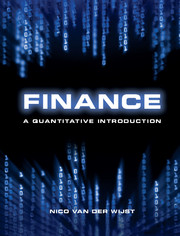Book contents
- Frontmatter
- Contents
- List of Figures
- List of Tables
- Acronyms
- Preface
- 1 Introduction
- 2 Fundamental concepts and techniques
- 3 Modern portfolio theory
- 4 Market efficiency
- Chapter 5 Capital structure and dividends
- 6 Valuing levered projects
- 7 Option pricing in discrete time
- 8 Option pricing in continuous time
- 9 Real options analysis
- 10 Selected option applications
- 11 Hedging
- 12 Agency problems and governance
- Solutions to exercises
- Glossary
- References
- Index
Preface
Published online by Cambridge University Press: 05 February 2013
- Frontmatter
- Contents
- List of Figures
- List of Tables
- Acronyms
- Preface
- 1 Introduction
- 2 Fundamental concepts and techniques
- 3 Modern portfolio theory
- 4 Market efficiency
- Chapter 5 Capital structure and dividends
- 6 Valuing levered projects
- 7 Option pricing in discrete time
- 8 Option pricing in continuous time
- 9 Real options analysis
- 10 Selected option applications
- 11 Hedging
- 12 Agency problems and governance
- Solutions to exercises
- Glossary
- References
- Index
Summary
Preface
Finance has undergone spectacular changes in the last four decades, both as a profession and as a scientific discipline. Before 1973 there were no option exchanges and there was no generally accepted model to price options. Today, the worldwide trade in derivative securities represents a much larger money amount than the global production of goods and services. The famous Black and Scholes option-pricing formula and its descendants are used in financial markets all over the world where an enormous number of derivative securities are traded every day. Professionals in sectors like engineering, telecommunications and manufacturing regularly find that their projects are evaluated with techniques such as real options analysis. Understanding the basic concepts of finance is increasingly becoming a prerequisite for the modern work place.
Many scientific developments in finance are fuelled by the use of quantitative methods; finance draws heavily on mathematics and statistics. This gives students and professionals who are familiar with quantitative techniques an advantage in mastering the principles of finance. As the title suggests, this book gives an introduction to finance in a manner and ‘language’ that are attuned to an audience with quantitative skills. It uses mathematical notations and derivations where appropriate and useful. But the book's main orientation is conceptual rather than mathematical; it explains core financial concepts without formally proving them. Avoiding the definition-theorem-proof pattern that is common in mathematical finance allows the book to use the more natural order of first presenting an insight from financial economics, then demonstrating its empirical relevance and practical applicability, and concluding with a discussion of the necessary assumptions. This ‘reversed order’ reduces the scientific rigour but it greatly enhances the readability for novice students of finance. It also allows the more demanding parts to be skipped or made non-mandatory without loss of coherence.
Information
- Type
- Chapter
- Information
- FinanceA Quantitative Introduction, pp. xiv - xviPublisher: Cambridge University PressPrint publication year: 2013
